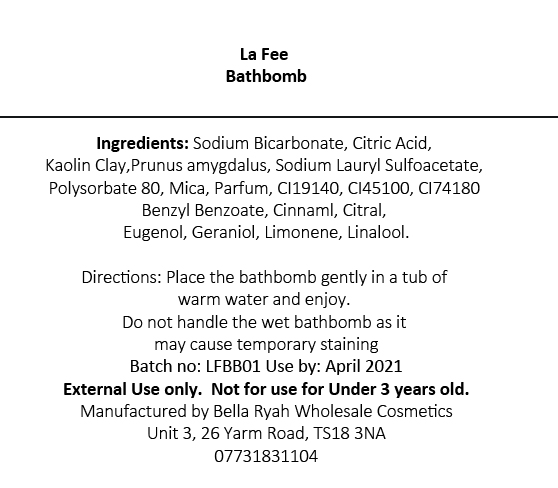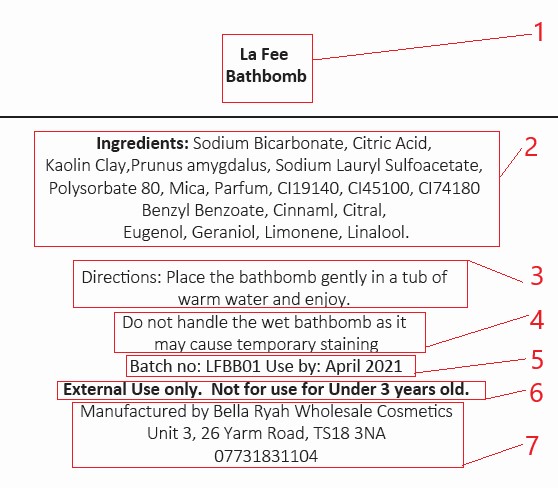How to make product labels for Bath Bombs and Cosmetics
Correct labelling is an important part of selling your hand made items legally. This guide will explain piece by piece, how to label your items properly.
Correct for the EU at time of writing- always follow any advice from your assessor and assessment report.

The above label is simple, effective and clean looking. It is the label for a bath bomb. We will spilt it down into smaller components which we have numbered 1 -7.

1
La Fee Bathbomb- This is the product name, and explains what the product it is. It is also the name that the product has been registered on the portal as.
“La Fee” would be too vague, and the user wouldn’t know what the product is.
“bathbomb” would also be very vague- offering no clarity into that name.
In this instance “La Fee” is the name of the bath bomb, as given by the maker.
2
This area is where the ingredients are listed.
Ingredients are always listed using their International Nomenclature of Cosmetic Ingredients (INCI) names.
You will be able to find the ingredients INCI names in your assessment.
“Prunus Amygdalus “in this label should read ‘Prunus Amygdalus Dulcis, and is the INCI for ‘Sweet Almond Oil’, however we have left the error present to demonstrate just how easily an error can occur, and to highlight the importance of checking your assessment information.
Ingredients are always listed in weight order, in a descending order from largest, to smallest. Most assessments are written in a way which shows the ingredients used in the same layout- Normally in highest to lowest by %. This will make your labelling job easier.
Any colourant Micas need adding by their CI number. Micas from different suppliers have varied ingredients, some contain ‘Mica’ and others do not. If “Mica” is present and listed on your assessment, then it should be on your ingredients list.
In this example, the Mica used is a glittery mica, and it was used in a large quantity to produce glittery water. It is not that common to see “Mica” as high up on an ingredients label, and would normally come after parfum.
After the colour CI numbers, you will see the Allergens listed. These are normally last as they generally have the lowest percentage of your product. You will notice these are not in bold. some makers do put them in a bold font, however it is not a legal requirement for a cosmetic product.
3
User directions, pretty self explanatory and some reports will have these listed too
4
Customer advice- This sort of information is not a required part of labelling, but is good practice to add. They can contain things which are not unsafe from a cosmetic point of view, but something you would like your customer to be aware of. If you produce a very oily nourishing bath melt, which can make the bath very slippery for example, then it may be worth writing that your product can cause this slippery surface.
5
Batch number, and Expiry. Check your assessment and see what the stipulations are. Some assessments will specify “PAO” (Period after opening) which can be symbolised with the small pot symbol with a time scale on.
6
Any warnings that your product requires. Usually listed in your assessment. E.g. Some colourants cannot be used around the eye area etc.
7
Manufacturers contact details. This is a legal requirement. You must provide an address, and also a phone number. The address can be condensed to include just your building number, and postcode.
e.g:
123 South Street,
Tipton,
West Midlands,
DY55 7HJ
Can be recorded as: 123, DY55 7HJ.
